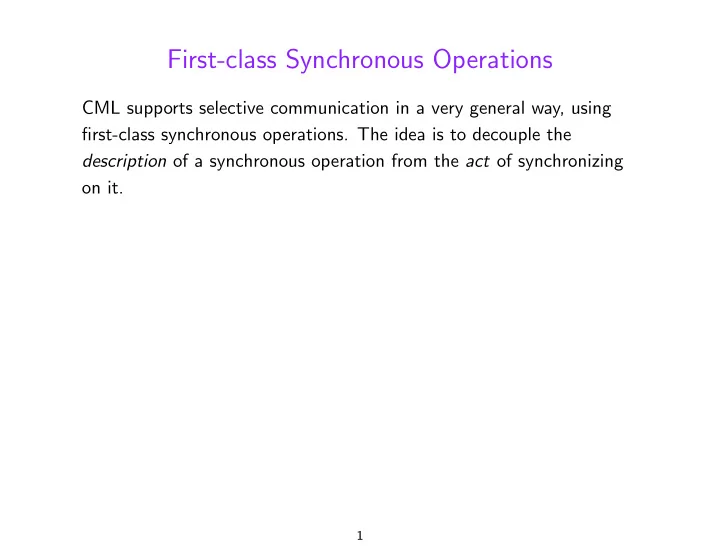

First-class Synchronous Operations CML supports selective communication in a very general way, using first-class synchronous operations. The idea is to decouple the description of a synchronous operation from the act of synchronizing on it. 1
First-class Synchronous Operations CML supports selective communication in a very general way, using first-class synchronous operations. The idea is to decouple the description of a synchronous operation from the act of synchronizing on it. Synchronous operations are described as synchronization events, and may be synchronized on using the function sync : type ’a event val sync : ’a event -> ’a Synchronizing on a value of type ’a event will produce, if successful, a value of type ’a . Synchronization may only succeed if an event is enabled . 1-a
Event Operations (* base events *) val sendEvt : ’a chan * ’a -> unit event val recvEvt : ’a chan -> ’a event val alwaysEvt : ’a -> ’a event val never : ’a event val timeOutEvt : Time.time -> unit event val joinEvt : thread_id -> unit event (* combinators *) val wrap : ’a event * (’a -> ’b) -> ’b event val choose : ’a event list -> ’a event (* values provided for convenience/efficiency *) val recv : ’a chan -> ’a val send : ’a chan * ’a -> unit val select : ’a event list -> ’a recv = sync o recvEvt send = sync o sendEvt select = sync o choose 2
Example of Semantics We’ll study the semantics of CML later on. For now, though, let’s look at an example. Suppose ch1 is a bool chan and ch2 is an int chan . Let ev be the unit event choose [wrap(sendEvt(ch1, true), fn () => print "send!\n"), wrap(recvEvt ch2, fn x => print("received: " ^ Int.toString x ^ "\n")), wrap(timeOutEvt(Time.fromSeconds 3), fn () => print "timeout!\n")] 3
Example of Semantics We’ll study the semantics of CML later on. For now, though, let’s look at an example. Suppose ch1 is a bool chan and ch2 is an int chan . Let ev be the unit event choose [wrap(sendEvt(ch1, true), fn () => print "send!\n"), wrap(recvEvt ch2, fn x => print("received: " ^ Int.toString x ^ "\n")), wrap(timeOutEvt(Time.fromSeconds 3), fn () => print "timeout!\n")] If we synchronize on ev , then CML will wait for at least one of the three base events to become enabled. At such points, ev itself is enabled, and CML may randomly choose one of the enabled events to synchronize on, supply the value of this synchronization to the function that is wrapped around it, and then return the value returned by this function ( () , in all three cases) as the result of synchronizing on ev . 3-a
The Utility of First-class Synchronous Operations The separation of synchronization into two parts allows: • the definition of synchronization and communication abstractions that may be used in selective communication; • selective communication involving dynamically computed possibilities. 4
Recommend
More recommend